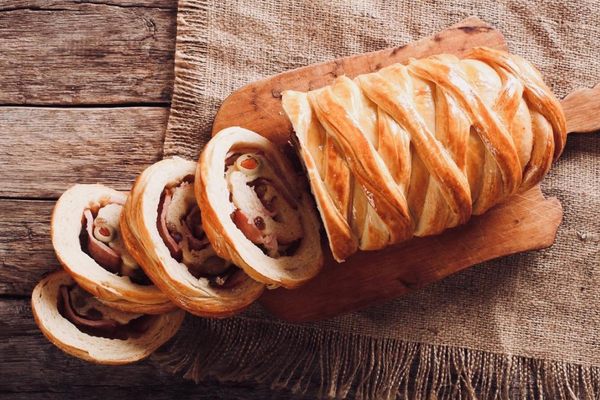Sweets
Gata
Outside chapels carved from cliffs and caves, elderly women sell sweet, beautiful breads rooted in Armenia’s Christian traditions.
In the rugged Upper Azat Valley in Armenia, around the entrance to the rock-carved Geghard Monastery, you’ll notice elderly ladies clustered around roadside stalls leading to the site, selling round Gata cakes inscribed with patterns and intricate Armenian script.
The glazed pastry has a crusty texture that’s soft once you bite into it, and is stuffed with a sweet filling (khoriz) made from a fluffy mixture of flour, butter, and sugar, with a consistency of baked custard. Though styles will vary between regions and villages—with variants including matsuni (Armenian yogurt), walnuts, or dried fruit in the filling—the most famous version comes from the villages around Geghard and Garni, where locals will decorate these round pastries with tree-like motifs, diamond shapes, hearts, or words (such as “Geghard”).
These delicious cakes, which are actually more like a sweetened kind of bread, have their roots in religious tradition. Armenia adopted Christianity in the fourth century after the religious leader Gregory the Illuminator baptized the royal family. Shortly thereafter, Gregory identified a sacred spring in a cave at Geghard and the first chapel was built inside. In the centuries that followed, monks built more formal structures, including the most prominent chapel in 1215, using rocks from surrounding cliffs.
While it’s unclear when vendors started selling Gata cakes at the site, the treats have been linked to Christian traditions for some time. They’re particularly prevalent during the Christian holiday of Candlemas (Tiarn’ndaraj). According to the Armenian Apostolic Church’s calendar, the celebration occurs 40 days after Christmas and commemorates when the baby Jesus was presented at the temple in Jerusalem. Armenian women knead their love and warmth for their family into the dough, so that each cake bestows peace and success upon their household. In addition to love and flour, a coin is often hidden inside the bread. The person to get the coin will enjoy good luck all year.
Where to Try It
-
Geghard Monastery
Geghard Monastery, Goght, Armenia
Written By
 jwalker
jwalker

















